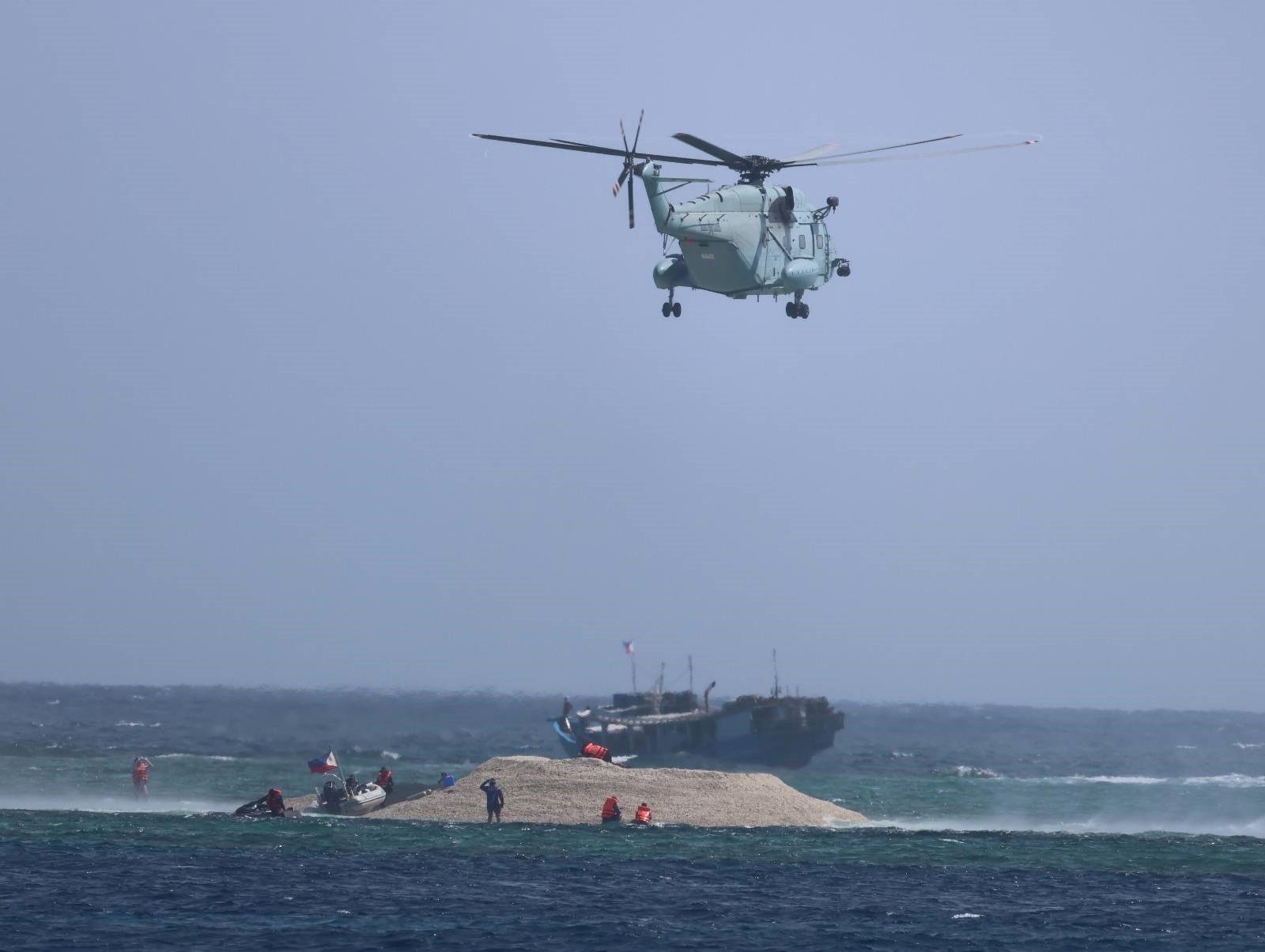China’s chopper harasses PH researchers near Pag-asa

TOO CLOSE A helicopter from China’s People’s Liberation Army hovers above Cay 3, near Pag-asa Island, where Filipino researchers are assessing underwater reef biodiversity. —PHOTO COURTESY OF PHILIPPINE COAST GUARD AND BUREAU OF FISHERIES AND AQUATIC RESOURCES
A Chinese Navy helicopter harassed Filipino researchers conducting a survey at sandbars off the Philippine-occupied Pag-asa (Thitu) Island on Saturday, the same day that China Coast Guard (CCG) ships assaulted a Philippine supply boat with water cannons near Ayungin (Second Thomas) Shoal in the West Philippine Sea, a Philippine Coast Guard (PCG) official said.
The People’s Liberation Army Navy helicopter with tail No. 57 hovered above at a close distance of 20 meters while the researchers were conducting a survey at Cays 3 and 4, part of the four sandbars off Pag-asa, PCG spokesperson for the West Philippine Sea Commodore Jay Tarriela told the Inquirer on Sunday.
READ: Chinese vessel again tries to block PH research vessel
The chopper’s downwash was a “dangerous” attempt to drive away the researchers in the mission, he noted.
Invited Japanese journalists also witnessed the incident. In one video shown to the Inquirer, the Filipinos panicked while sand and corals splashed as the chopper hovered closely from above.
The chopper flew at a low distance for more than five minutes.
The Filipino researchers were part of a joint marine research expedition composed of the PCG, the University of the Philippines Institute of Biology, the Bureau of Fisheries and Aquatic Resources (BFAR), and the Department of Agriculture-National Fisheries Research and Development that were also harassed last week by the Chinese coast guard and militia ships in two other sandbars.
The research team was tasked to assess underwater reef biodiversity in the four sandbars.
Last year, piles of dead corals that appeared to be deliberately dumped in one of the sandbars have raised concerns from some sectors, as this was a move that allegedly precedes Chinese reclamation activities.
There are four sandbars within Pag-asa’s 22-kilometer territorial sea that is adjacent to its neighboring military outpost in Zamora (Subi) Reef, one of China’s artificial military outposts located about 26 km away.
Filipino fishermen in Pag-asa have repeatedly accused Chinese ships of driving them away from these sandbars whenever they go out to fish.
Pag-asa, some 480 km from Palawan’s capital Puerto Princesa City, is the biggest of the nine features occupied by the Philippines in the Kalayaan Island Group, a fifth-class municipality with about 200 residents.
Recent years saw the rehabilitation of a 1.3-km runway and the construction of a sheltered port, a beaching ramp, and other civilian facilities on the island to assert the country’s sovereignty in the West Philippine Sea.
During Saturday’s incident, Chinese coast guard and militia vessels consistently shadowed BFAR ships Datu Sanday (MMOV-3002) and Datu Pagbuaya (MMOV-3003) and their rubber boats tasked to transport the researchers to the sandbars.
The Chinese coast guard blew its horns intimidatingly at some point and both sides repeatedly exchanged radio challenges throughout.
Tasks completed
Despite the harassment, the researchers were able to complete their tasks and obtain samples needed for study.
Tarriela said the Philippines’ marine scientific research off Pag-asa was lawful because it was within the island’s territorial sea.
“The PCG and BFAR remain undeterred by the illegal presence of Chinese maritime forces and their provocative actions. We are committed to conducting marine scientific research in the West Philippine Sea to enhance our understanding of our coral reef diversity and aquatic resources,” he said.
Former Supreme Court Associate Justice Antonio Carpio, a staunch critic of China’s expansionist claims, warned that if China occupies a sandbar, it will generate a 22-kilometer territorial sea including Zamora Reef.
“Pag-asa’s territorial sea is reduced by a third, and Pag-asa also loses [Zamora] Reef as its territorial sea,” he told the Inquirer. INQ



